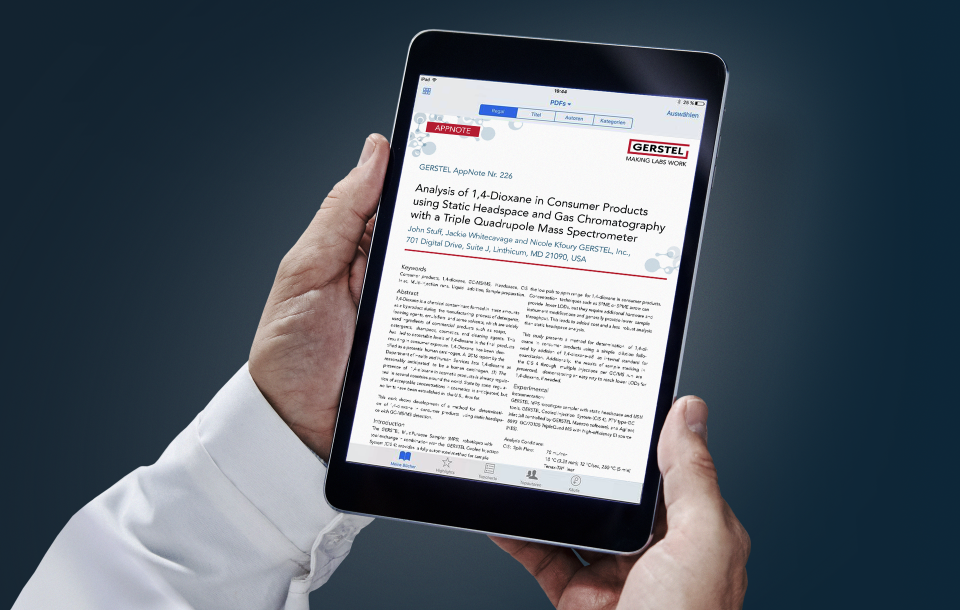With the global surge in the use of electronic cigarettes, there is a corresponding increase in the consumption of e-liquid. Howev-er, different regions and countries impose varying regulatory re-quirements concerning the types and concentrations of flavorings added to electronic liquids (e-liquids). Analyzing the flavorings in e-liquids poses a challenge due to their substantial content of pro-pylene glycol, glycerol solvent, and nicotine as a matrix.
Liquid-liquid extractions are used to extract and concentrate an-alytes from aqueous matrices. This extraction technique is wide-ly accepted, as shown by its inclusion in many official methods. Analytical laboratories are looking to automation to help reduce solvent usage and increase sample throughput while ensuring the high quality of the resulting data.
The GERSTEL MultiPurpose Robotic Smart Series Sampler (MPS), commonly used for sample introduction into GC or HPLC, can perform a wide variety of sample preparation techniques using a single instrument and controlling software. The sampler can be configured as part of a GC or LC system or as a bench-top work-station.
Leather and leather-like materials are used in various products such as baseball gloves, furniture, clothing, shoes, car interiors, phone cases, etc. One comes in contact with these types of mate-rials through normal daily activities. Leather is made from animal skin. The skin is composed of a fibrous collagen network. Collagen is a structure-forming protein consisting of three peptide chains in a triple helix structure.
Leather-like materials can comprise different polymers, including polyurethane, nylons, polycarbonate, polyethers, and polyesters. They are often a combination of these materials.
The global nail polish market was estimated at over $15 billion (USD) in 2023 and is expected to grow at a rate greater than 8% between 2024 and 2033. There are two main types of chemistry used for nail polish. The first is nitrocellulose dissolved in a sol-vent. The nitrocellulose hardens after the solvent evaporates. The other chemistry is based on acrylic polymers which polymerize as part of the application process. Other chemicals added to the pol-ish may include photoinitiators, stabilizers, solvents, plasticizers, pigments, thickeners, and even fragrances.
Scented products, including car air fresheners, soaps and deter-gents, candles, and even garbage bags, are ubiquitous in our ev-eryday lives. They are primarily intended to cover up malodors but can also enhance one’s mood or be used in aromatherapy.
Thermal desorption is an introduction technique for gas chro-matography that can be used for a wide variety of applications, including the analysis of fragrance compounds in consumer prod-ucts. Options for thermal desorption include direct thermal ex-traction, Twister, Thin Film SPME, air sampling, and direct injection of liquids.
The plant-based protein market has been booming in the past few years. However, flavor remains the most significant barrier to overcome. Specifically, it is a challenge to maintain the flavor of plant-based meat alternative products as they age in storage. In this study, a sensory directed analysis (SDA) approach was em-ployed to determine if adding rosemary extract, with antioxidant properties, could maintain freshness in plant-based meat alterna-tives in the form of a burger patty. The method utilized dynam-ic headspace (DHS) sample extraction and gas chromatographic separation paired with simultaneous olfactometry and mass spec-trometric detection (GC-O/MS).
Measurements for per- and polyfluoroalkyl substances (PFAS) in air have expanded. There are few analytical methods available which measure PFAS in air. Thermal desorption, gas chromatography, and tandem mass spectrometry (TD-GC-MS/MS) is being successfully used for this purpose by the US EPA for the evaluation of indoor air and indoor materials using a simple, valve-free thermal desorber architecture.
The collection of volatile organic compounds (VOCs) from ambient air is either achieved actively by sampling onto a sorbent tube using a sampling pump, or passively using the tube as a diffusive sampler without pumping air through it. Active sampling is preferable because of easier quantification, shorter sampling time, and wider compound range that can be determined using a single tube.
In the work presented here, the PFAS listed in EN 17892, including the substance list in EU Drinking Water Directive (EU 2020/2184), were determined by an automated method based on solid phase extraction with weak anion exchange sorbent combined with LCMS/ MS. Recovery rates, blank values, and limits of quantification (LOQ) were determined following the requirements of the EN 17892 method. The method accuracy was demonstrated based on analysis of spiked water samples from different sources. LOQs in drinking water were below 0.5 ng/L for the vast majority of compounds.
Compostable products have gained popularity due to their green environmental claims. However, most of these materials are not strictly plant-based nor are they disposed of at the proper industrial composting sites. In this study, the GERSTEL PYRO Core system enables efficient automation of the thermal extraction and pyrolysis of three compostable and/or biodegradable materials and two natural sources.
Pagination
- Previous page
- Page 3
- Next page
